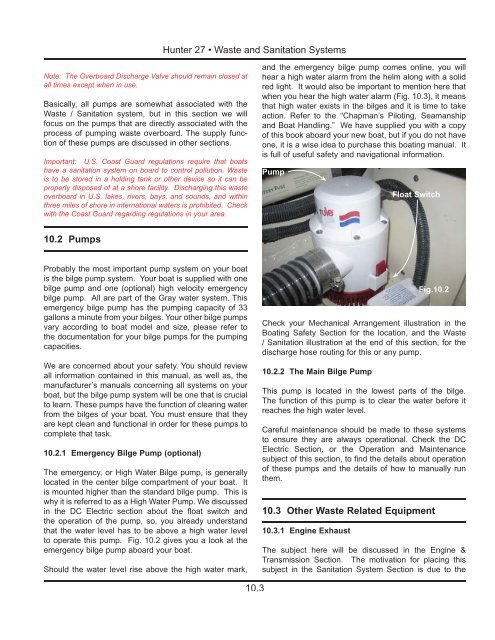27 Operator's Manual.. - Marlow-Hunter, LLC
27 Operator's Manual.. - Marlow-Hunter, LLC
27 Operator's Manual.. - Marlow-Hunter, LLC
Create successful ePaper yourself
Turn your PDF publications into a flip-book with our unique Google optimized e-Paper software.
<strong>Hunter</strong> <strong>27</strong> • Waste and Sanitation Systems<br />
Note: The Overboard Discharge Valve should remain closed at<br />
all times except when in use.<br />
Basically, all pumps are somewhat associated with the<br />
Waste / Sanitation system, but in this section we will<br />
focus on the pumps that are directly associated with the<br />
process of pumping waste overboard. The supply function<br />
of these pumps are discussed in other sections.<br />
Important: U.S. Coast Guard regulations require that boats<br />
have a sanitation system on board to control pollution. Waste<br />
is to be stored in a holding tank or other device so it can be<br />
properly disposed of at a shore facility. Discharging this waste<br />
overboard in U.S. lakes, rivers, bays, and sounds, and within<br />
three miles of shore in international waters is prohibited. Check<br />
with the Coast Guard regarding regulations in your area.<br />
and the emergency bilge pump comes online, you will<br />
hear a high water alarm from the helm along with a solid<br />
red light. It would also be important to mention here that<br />
when you hear the high water alarm (Fig. 10.3), it means<br />
that high water exists in the bilges and it is time to take<br />
action. Refer to the “Chapman’s Piloting, Seamanship<br />
and Boat Handling.” We have supplied you with a copy<br />
of this book aboard your new boat, but if you do not have<br />
one, it is a wise idea to purchase this boating manual. It<br />
is full of useful safety and navigational information.<br />
Pump<br />
Float Switch<br />
10.2 Pumps<br />
Probably the most important pump system on your boat<br />
is the bilge pump system. Your boat is supplied with one<br />
bilge pump and one (optional) high velocity emergency<br />
bilge pump. All are part of the Gray water system. This<br />
emergency bilge pump has the pumping capacity of 33<br />
gallons a minute from your bilges. Your other bilge pumps<br />
vary according to boat model and size, please refer to<br />
the documentation for your bilge pumps for the pumping<br />
capacities.<br />
We are concerned about your safety. You should review<br />
all information contained in this manual, as well as, the<br />
manufacturer’s manuals concerning all systems on your<br />
boat, but the bilge pump system will be one that is crucial<br />
to learn. These pumps have the function of clearing water<br />
from the bilges of your boat. You must ensure that they<br />
are kept clean and functional in order for these pumps to<br />
complete that task.<br />
10.2.1 Emergency Bilge Pump (optional)<br />
The emergency, or High Water Bilge pump, is generally<br />
located in the center bilge compartment of your boat. It<br />
is mounted higher than the standard bilge pump. This is<br />
why it is referred to as a High Water Pump. We discussed<br />
in the DC Electric section about the float switch and<br />
the operation of the pump, so, you already understand<br />
that the water level has to be above a high water level<br />
to operate this pump. Fig. 10.2 gives you a look at the<br />
emergency bilge pump aboard your boat.<br />
Should the water level rise above the high water mark,<br />
Check your Mechanical Arrangement illustration in the<br />
Boating Safety Section for the location, and the Waste<br />
/ Sanitation illustration at the end of this section, for the<br />
discharge hose routing for this or any pump.<br />
10.2.2 The Main Bilge Pump<br />
This pump is located in the lowest parts of the bilge.<br />
The function of this pump is to clear the water before it<br />
reaches the high water level.<br />
Careful maintenance should be made to these systems<br />
to ensure they are always operational. Check the DC<br />
Electric Section, or the Operation and Maintenance<br />
subject of this section, to find the details about operation<br />
of these pumps and the details of how to manually run<br />
them.<br />
10.3 Other Waste Related Equipment<br />
10.3.1 Engine Exhaust<br />
Fig.10.2<br />
The subject here will be discussed in the Engine &<br />
Transmission Section. The motivation for placing this<br />
subject in the Sanitation System Section is due to the<br />
10.3

















